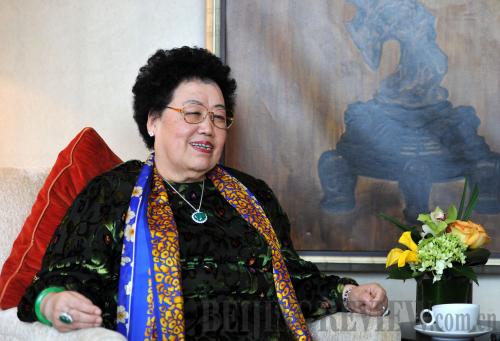|
 |
|
ARTISTIC BILLIONAIRE: Chen Lihua, a real estate tycoon and founder of the Red Sandalwood Museum in Beijing (WANG LEI) |
The Red Sandalwood Museum established by real estate tycoon Chen Lihua in Beijing is one of the biggest private museums in China. The museum accommodates nearly 1,000 pieces of red sandalwood furniture and sculpture.
Chen had invested more than 200 million yuan ($32.64 million) in her 25,000-square-meter museum before it opened to the public in 1999. The museum's annual operational expenses stand around 20 million yuan, mainly coming out of Chen's pocket. A miniature sandalwood-and-ebony Yongding Gate, a model of one of old Beijing's city gates, was added to the museum's collection in January and is said to cost more than 100 million yuan ($16.32 million) in wood alone.
As one of China's earliest private museums, the Guanfu Museum was founded by writer and collector Ma Weidu in Beijing in 1996. It is divided into sections, showcasing furniture, oil paintings, porcelain and other items. Guanfu operates with public donations, similar to many of its counterparts in the West. It is also one of the few private museums in China that has introduced a board system.
Ma told Beijing-based Guangming Daily that as far as he knows his museum is the only private museum in China turning a profit without any backing by a company. However, the profits have also given his museum a financial burden because they are taxed as corporate income. Over the years, Ma's museum has paid a total of 1 million yuan ($163,000) in taxes, though under Chinese laws, private museums are categorized as "private non-business entities," which technically means they can enjoy tax breaks, subsidies and other favorable government policies.
Meanwhile, an ancient pottery museum in Beijing faces a gloomy future since its founder Lu Dongzhi died in 2011. "With my husband's death, the reliable source of funding is gone," said Dong Rui, Lu's widow who has since assumed curatorship. Tickets to this museum in the corner of a park are priced at 50 yuan ($8). However, ticket revenue is still far from covering the museum's annual operational expenses of 500,000 yuan ($81,600).
"Our friends used to tell us that it is a luxurious hobby to establish and run a museum, but I don't know what the museum's future is. I'm doing my best to keep the door open," Dong said.
Government incentives
In cities like Beijing, the government has started to subsidize private museums. For example, Beijing's Chaoyang District, which has 18 registered private museums or three fourths of the city's total, has encouraged the development of private museums since 2011.
The district government has earmarked a fund of 2 million yuan ($323,000) to support private museums every year.
Nationally, the State Administration of Cultural Heritage, the State Administration of Taxation and five ministries jointly issued a document on promoting the development of private museums in January 2010. One clause says that the government shall offer private museums practical help to find venues and funding. However, this policy has not been implemented fully in some parts of the country.
"The level of its implementation is closely linked to a region's economic development and local people's cultural demands," said Zhao Shuguang, chief of the Museums Department of the Cultural Heritage Bureau of north China's Shanxi Province. He said that while governments in wealthier regions are generous in supporting private museums, in poorer regions even state-owned museums can hardly make ends meet due to the lack of government funding.
Chen Qingyun is the founding curator of a museum in Shanxi's Yongji City that exhibits his personal collection of ancient porcelain, pottery and weapons. Since he sold his only apartment to support the establishment of his museum in 2001, he has hardly benefitted from any support or incentives from the government. To support himself, Chen has partnered with other historical attractions in the city to house his collection and relies on ticket revenue divided between him and his partners as the only source of his income. To expand his collection, Chen was forced to auction some exhibits and borrow money from friends.
Chen's largest concern is finding his collection a new home after the contract with the current partner terminates in October. "I am a bit burnt out."
Email us at: lili@bjreview.com | 